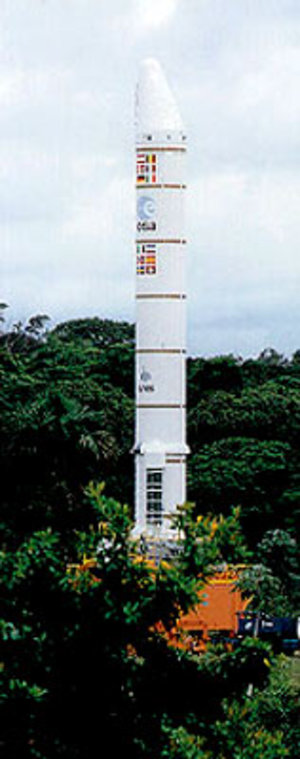Ariane 5 Generic

| Ariane 5G | |
|---|---|
| Height* | 46 to 52 m |
| Diameter | up to 5.4 m |
| Liftoff mass** | 746 tonnes |
| Payload mass*** | 6 tonnes GTO & 9.5 tonnes SSO |
Ariane 5 made its first successful launch on 30 October 1997. Its first operational flight took place in December 1999 when it launched ESA’s X-ray Multi-Mirror (XMM) satellite. Ariane 5 launched satellites for communications, Earth observation and scientific research.
Ariane 5 was used for launches into geostationary transfer orbit (GTO), medium and low Earth orbits, Sun-synchronous orbits (SSO) and Earth-escape trajectories.
All Ariane 5 versions were composed of a central core stage to which two solid boosters were attached. On top of this, different upper stage configurations were used.
In order to launch Ariane 5, ESA built a new launch site at Europe’s Spaceport near to the town of Kourou in French Guiana, as well as facilities to integrate the solid boosters and to produce the solid propellant used by the boosters.
* Depending on upper composite configuration
** Double launch
*** Dual launch, mass of spacecraft and adaptors
GTO = Geosynchronous Transfer Orbit (580 km x 35786 km x 7°)
SSO = Sun Synchronous Orbit (800 km x 800 km x 98.6°)















 Germany
Germany
 Austria
Austria
 Belgium
Belgium
 Denmark
Denmark
 Spain
Spain
 Estonia
Estonia
 Finland
Finland
 France
France
 Greece
Greece
 Hungary
Hungary
 Ireland
Ireland
 Italy
Italy
 Luxembourg
Luxembourg
 Norway
Norway
 The Netherlands
The Netherlands
 Poland
Poland
 Portugal
Portugal
 Czechia
Czechia
 Romania
Romania
 United Kingdom
United Kingdom
 Slovenia
Slovenia
 Sweden
Sweden
 Switzerland
Switzerland



































